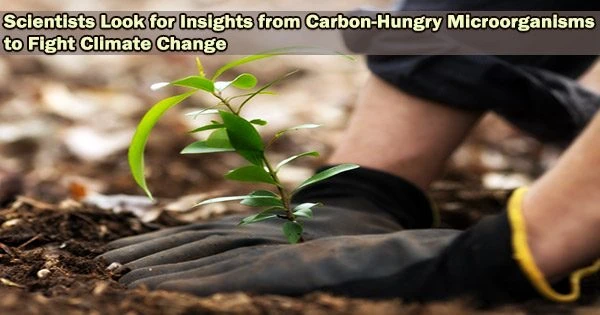Berkeley Lab researchers have demonstrated a novel method for converting carbon dioxide (CO2) into liquid acetate, a necessary component for creating “liquid sunlight” or solar fuels through artificial photosynthesis. This method was inspired by a metabolic process observed in some bacteria.
The novel strategy, described in Nature Catalysis, may progress the development of carbon-free substitutes for fossil fuels that are responsible for climate change and global warming.
The research also represents the first demonstration of a machine that can produce acetate the same way that these bacteria do in nature, using electrons and CO2.
“What’s amazing is that we learned how to selectively convert carbon dioxide into acetate by mimicking how these little microorganisms do it naturally,” said senior author Peidong Yang, who holds titles of senior faculty scientist in Berkeley Lab’s Materials Sciences Division and professor of chemistry and materials science and engineering at UC Berkeley.
“Everything we do in my lab to convert CO2 into useful products is inspired by nature. In terms of mitigating CO2 emissions and fighting climate change, this is part of the solution.”
The ability of some bacteria to consume electrons and CO2 to generate acetate, a reaction powered by electrons, has long been known to scientists. A carbonyl group (CO) or a methyl group are the two distinct or “asymmetric” chemical groups that result from the pathway’s breakdown of CO2 molecules (CH3).
The carbons in CO and CH3 are given the opportunity to “couple” by enzymes in this reaction pathway, which sets off a second catalytic process that results in the ultimate product, acetate.
Finding synthetic electrocatalysts that function as effectively as the enzymatic catalysts produced naturally by bacteria has proven difficult. This has prevented researchers in the field of artificial photosynthesis from creating devices that mimic the chemistry of the pathway known as asymmetric carbon-carbon coupling.
What’s amazing is that we learned how to selectively convert carbon dioxide into acetate by mimicking how these little microorganisms do it naturally. Everything we do in my lab to convert CO2 into useful products is inspired by nature. In terms of mitigating CO2 emissions and fighting climate change, this is part of the solution.
Peidong Yang
“But we thought, if these microorganisms can do it, one should be able to mimic their chemistry in the lab,” Yang said.
Advancing artificial photosynthesis with carbon-hungry copper
The ability of copper to transform carbon into a variety of beneficial chemicals was initially identified in the 1970s. These earlier investigations led Yang and his team to conclude that copper-catalyzed artificial photosynthesis devices should be capable of converting CO2 and water into methyl and carbonyl groups, which can subsequently be transformed into acetate.
Yang and team created a model device with a copper surface for one experiment, exposed the copper surface to liquid methyl iodide (CH3I) and CO gas, and then biased the system electrically.
According to the researchers’ theory, CO would adhere to the surface of copper, causing the asymmetric coupling of CO and CH3 groups to generate acetate. In the tests, isotope-labelled CH3I was employed to monitor the reaction route and byproducts. (An isotope is an atom with more or fewer neutrons (uncharged particles) in its nucleus than other atoms of an element.)
And they were right. Yang’s lab at UC Berkeley conducted chemical analysis studies that showed that copper’s coupling of carbonyl and methyl groups created not just acetate but also other useful liquids like acetone and ethanol. The researchers were able to determine that the acetate was produced by the reaction of CO and CH3 thanks to the isotopic tracking.
In another experiment, the researchers synthesized an ultrathin material from a solution of copper and silver nanoparticles, each one just 7 nanometers (billionths of a meter) in diameter. The researchers then designed another model device, this time layered with the nanoparticle thin material.
As expected, the electrical bias triggered a reaction, driving the silver nanoparticles to convert CO2 into a carbonyl group, while the copper nanoparticles transformed CO2 into a methyl group. Subsequent analyses in the Yang lab revealed another reaction (the coveted asymmetric coupling) between CO and CH3 synthesized liquid products such as acetate.
Through electron microscopy experiments at the Molecular Foundry, the researchers learned that the copper and silver nanoparticles are in close contact with each other, forming tandem systems and that the copper nanoparticles served as the catalytic center for asymmetric coupling.
Yang said that these copper-silver nanoparticles could potentially be coupled with light-absorbing silicon nanowires in the future design of efficient artificial photosynthesis systems.
In 2015, Yang co-led a study that demonstrated an artificial photosynthesis system comprised of semiconducting nanowires and bacteria using the energy in sunlight to produce acetate from carbon dioxide and water. The finding had significant implications for a growing field in which researchers have spent decades looking for the best chemical reactions to produce high yields of liquid products from CO2.
The new study advances this earlier work by demonstrating a synthetic electrocatalyst the copper-silver nanoparticles that “clearly mimics what bacteria do to produce liquid products from CO2,” Yang said. “We still have a lot of work to do to improve it, but we’re excited by its potential to advance artificial photosynthesis.”
Researchers from Berkeley Lab and UC Berkeley participated in the study. This work was supported by the DOE Office of Science. The Molecular Foundry is a DOE Office of Science user facility at Berkeley Lab.





